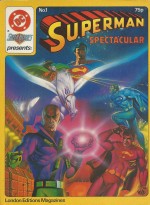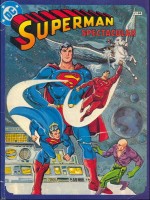

By Bob Rozakis, Paul Kupperberg, Adrian Gonzales & Vince Colletta (DC/London Editions)
ISBN: 0-86173-041-0
These days, when maintaining a faux-historical cloak of rational integrity for the made-up worlds comicbooks inhabit is paramount, the saddest casualty of those periodic sweeping changes, upgrades, rationalisations and reboots is the great stories that suddenly “never happenedâ€.
The most painful example of this – for me at least – was the wholesale loss of the entire bizarre and charm-drenched mythology that had evolved around Superman’s birthworld in the wonder years between 1948 and 1985.
Here then, in response to the new Superman film is something not every Kryptonian Kompletist may be treasuring in his vault: a canonical pre-Crisis on Infinite Earths Man of Steel yarn which didn’t appear in the regular runs of Superman or Action Comics, packed with all the gloriously convoluted lore, wry wit and all-ages thrills which for decades made the Man of Tomorrow indisputably the most recognisable comics character on Earth.
This extra-sized tale was actually devised by American creators for the European market as Superman Album series #1 (cover-dated Januar 1982 und pronounzed mit ein deutsche achzent, iff you pliss), printed in what was then West Germany by Ehapa Verlag.
It subsequently appeared in the USA as an English-language edition in a large (212 x 397mm) one-off paperback album in American convenience chains like 7-11 later that year. In Britain, where London Editions then held a DC reprint license, producing a wonderfully eclectic black-&-white anthology The Superheroes Monthly (with painted covers by the likes of Alan Craddock, David Jackson, Bryan Talbot and Brian Bolland), the tale was released as a similarly sized, full-colour edition to rack beside such beloved European imports as Asterix and Tintin.
In case you’re wondering: it was printed in Germany, presumably by simply replacing the black plate of the four-colour print process with one that had the lettering in English.
The ‘Startling Saga of Superman-Red & Superman-Blue!’ was scripted by Paul Kupperberg from a Bob Rozakis plot and illustrated by Adrian Gonzales & Vince Colletta, with the legendary Julius Schwartz in editorial command as always.
The bombastic battle royale was based on a much-beloved imaginary story by Leo Dorfman, Curt Swan & George Klein from Superman #162, July 1963, adroitly co-opted into the mainstream continuity to beef up the ominous if ill-starred alliance of arch nemesis Lex Luthor with space owlhoot Terra-Man.
(This last was conceived during the period when costumed heroes were in decline during the early 1970s. The Deep Space Desperado resembled a space-age Clint Eastwood in Spaghetti Western mode. He was a Wild West bandit’s son shanghaied into space. After eventually killing his kidnapper, the young man returned to Earth only to discover a century had passed. The furious outcast of infinity had already adapted his purloined extraterrestrial technology to accommodate his childhood antecedents and decided to drive aliens such as Superman off “his†planet forever…)
This intergalactic grudge match opens as Luthor invades a Daily Planet story conference to challenge Superman to another fight. The resulting clash goes badly for the criminal genius, however, even though he has devised an entirely new form of energy weapon to destroy his alien antithesis…
Meanwhile in space, solitary star rider Terra-Man has finally found a chunk of Kryptonite. He had long heard stories that the rare radioactive remnant was fatal to Superman, and now believes the end of his vendetta against the extraterrestrial squatter on his home range is near.
He should have listened more closely to the stories, though, as the shard he holds is red, not green…
Wary of being beaten again, Terra-Man contacts Luthor and proposes a combined attack, but doesn’t trust his new partner enough to hand over the radioactive space rock…
On Earth Superman is renewing his oft-postponed romance with Lois Lane when Terra-Man attacks, and after deflecting the initial assault is lured into orbit where the menacing mineral is secreted.
From his hiding place Luthor can only watch in horror as the Red K (which produced not radiation poisoning and death but temporary mutagenic effects on Kryptonians) divided the Man of Steel into twins in primarily blue or red uniforms…
It wasn’t a complete disaster, however, as each of the pair seemed to be missing some of Superman’s vast array of powers…
Frantically regrouping, Luthor and Terra-Man deduced what had happened, and as Clark Kent endured confusion at work with a brace of himself tripping over each other, the vile villains plotted to use their conventional resources and Lex’s new discovery to destroy their foe(s).
With double the super manpower, “Red†and “Blue†begin cleaning all the trouble spots on Earth and discover a new crisis: an inter-dimensional rift threatening to consume the world. The mystery of Luthor’s new energy source is revealed – the madman has tapped magical forces from another plane of existence and weaponised it to kill his arch foe, regardless of the potential for universal cataclysm…
As Supermans Red and Blue move to quell the threat, they find one more quandary confronting them: each is only half as powerful as the whole hero. When the divided defenders split up to battle Terra-Man and Luthor, this tragic deficiency causes the Crimson Crusader’s “death†with the collateral catastrophe of Lois felled by Luthor’s lethal magic weapon…
And at that very moment the Red K effect faded and the one true Man of Tomorrow was reborn…
Once upon a time smart, affecting absorbing drama and wild-eyed adventure such as this was the bread-and-butter of comics. For decades, new exploits and dangers were created – sometime three of four times a month – with characters operating seamlessly in a shared milieu that wasn’t obsessed with incessantly mining and refining the hero’s origin or shockingly revealing lost or evil relatives like some spandex-bedecked cheap soap opera. And they frequently began and ended in one issue…
This tale is a delicious example from the dying days of that era and perfectly shows us what we’re missing today…
© 1982 DC Comics Inc. This edition © 1982 London Editions Magazines (formerly Egmont Publishing). All Rights Reserved.
